Within the walls of an unassuming senior center in Santa Monica is one of the coolest ancient inventions ever created…the Camera Obscura.
What the hell is a Camera Obscura?

A camera obscura, or “dark chamber” in Latin, is a projector of sorts. It’s a completely dark box, tent, or room with a small hole in one side of it.
An exterior light source passes through that small hole, causing a projection of whatever it’s pointed toward to appear on the first flat surface it first comes into contact with. An exact replica from outside the box, chamber or tent appears, but it’s now inverted and reversed. Besides those two changes, it’s otherwise the same in terms of color and appearance.
A Brief History of Camera Obscuras
The camera obscura is believed to be one of the oldest optical inventions still in use today. Historians have estimated that the invention of the camera obscura might date back as far as the 4th century BCE! For context, that would have been around the time that Alexander the Great was doing his thing throughout the Mediterranean world.
Scholars attribute the earliest iteration of a camera obscura to the ancient Chinese philosopher, Mozi. Other prominent figures in ancient history including Aristotle, Anthemius of Tralles (who co-constructed the Hagia Sophia in Turkey), and Arab physicist Ibn al-Haytham (also known as Ibn Alhazen) have also been suggested as having contributed to the advancement of the camera obscura.
The Camera Obscura from the Middle Ages to the Renaissance
Because of the drastic shift from the stiff, rigid figures of Medieval art to the rounded realism of Renaissance art, art historians speculate that Renaissance artists may have used a camera obscura for perspective aid.
This speculation was possibly fueled by Leonardo da Vinci’s work. Da Vinci was a known proponent of the camera obscura, having written extensively about his observation of the similarity between the camera and the human eye.
His art has long been celebrated for it’s true-to-life qualities, attention to detail, and overall beauty; qualities that may have had some help from the camera obscura.

Vermeer & the Camera Obscura
In addition to da Vinci, Dutch Baroque artist, Johannes Vermeer, is probably one of the most discussed artists in regards to the use of the camera obscura by an artist. Due to the striking detail and complexity of patterns in his work, it’s believed that Vermeer also used a camera obscura for assistance.
In the documentary Tim’s Vermeer, inventor Tim Jenison attempts to reproduce Vermeer’s “The Music Lesson” solely with a camera obscura. I won’t spoil the ending, but I will say that it is a very intriguing hypothesis…gahh, I’ve said too much!
The 19th Century and the Invention of Photography

While artists continued to use the camera obscura to assist with developments in the art field, the camera itself changed and adapted over time.
By the 19th century, the camera obscura had evolved into a small, portable box. Housing the optical device in a small box allowed people to be able to travel with their cameras, allowing them to draw new and exciting people and destinations.
The portable camera obscura inspired famous early photographers like Nicéphore Niépce (1765-1833), Louis Daguerre (1787-1851), and Henry Fox Talbot (1800-1877) to further innovate.
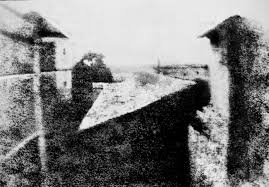
Niépce, Daguerre, and Talbot all sought to develop a method of achieving a permanent print through the camera obscura.
They each placed an acidic solution on a plate (of varying types), inserted it into the camera, waited a few hours, and produced a permanent print.
Niépce created the “sun drawing,” Talbot created the “calotype,” and Daguerre created the most well-known method of early photography, the Daguerreotype.
In addition to its use by photographers and artists, the camera obscura was also a popular seaside tourist attraction during the Victorian (1837-1901) and Edwardian (1901-1910) eras in both Europe and America.
It was during the Edwardian period when the Camera Obscura was brought to Santa Monica.
History of the Camera Obscura in Santa Monica
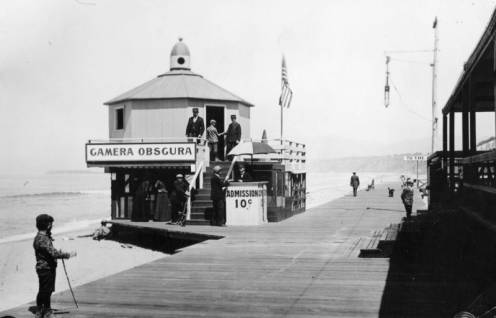
When he was a boy, Robert F. Jones experimented with creating camera obscuras. It wasn’t until his stint as Mayor of Santa Monica, though, when his passion for the camera obscura reached new heights.
Robert F. Jones served as Mayor of Santa Monica from 1894-1900. In 1898, he built his Camera Obscura on the beach. Two years before Jones created his masterpiece, a camera obscura had been built on Catalina Island and it’s possible that Jones wished to compete with its success. Jones claimed that the camera he built in 1898 was “one of the most perfect in existence.”
At the Camera in Santa Monica, people would walk up a rickety wooden staircase, pay 10 cents admission once they reached the top, and enter a completely dark room. Once their eyes adjusted from the shift of bright California sun to utter darkness, they would notice the large white disc-shaped table that sat at the center of the room and the projections on it.

The inhabitants and visitors to Santa Monica absolutely adored the Camera. The Los Angeles Herald even advertised it for four straight months in a special section called “There is Fun at Santa Monica.”

Movement to Westlake
In 1898, Mayor Jones petitioned to move the camera to the trendy Westlake district of Los Angeles. He invited the Board of Park Commissioners to visit Santa Monica in October 1898, with all of their travel expenses to be paid by him.
After viewing the camera, the Board unanimously approved that it could be moved to Westlake and so it was for a couple of months. There were, however, a few stipulations to this offer. In addition to building an acceptable shelter to house his Camera Obscura, it was only allowed to be displayed for 2 years AND Jones was to pay $50 per year to rent the space in Westlake…ouch.

Furthermore, the nincompoop residents of Westlake voiced some unfounded concerns about the Camera Obscura. The Los Angeles Herald reported that they were “…opposed to the innovation on the ground that it displays some obscene pictures.”
Despite the opposition of the Westlake residents, things appeared to proceed smoothly…for a little while. That is, until Mayor Jones and the Board of Park Commissioners suffered another disagreement, this time about money.
According to an article from the Los Angeles Herald dated January 27, 1899:
“The removal of one of the summer houses at Westlake park to make place for the camera obscura cost about $20. This amount had been expended by Robert Jones, the proprietor of the obscura, but he believed that he should not be charged with this expense. He asked that the park department credit him with this expense when it comes to paying for the obscura privilege next year. The commissioners did not favorably consider this demand, but decided to lay it over for a week for investigation.”
Well, as you can imagine, the Board did “…lay it over for a week for investigation,” but ultimately would not budge.
Sweet Home, Santa Monica!
After the brief sojourn to Westlake, Jones’ Camera Obscura was sent back to its original home in Santa Monica. When it returned, the Camera received a new structure: a wooden “shack-like” house.
Despite being placed in a wooden shack, the people of Santa Monica were happy to have their Camera Obscura back. In 1910, the city of Santa Monica bought it to increase tourists along Ocean Avenue. It appears to have worked because contemporary newspapers report that several hundred people visited it every day!
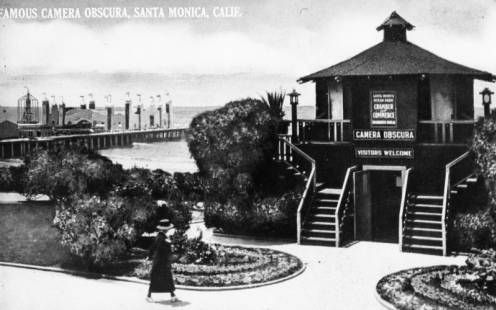
In addition to being a fun, novelty item, the camera was also a pseudo patrol person! The Camera reportedly helped lifeguards keep an eye out in the water and on the beach, and also assisted the police in catching a burglar in action. The robber was caught trying to steal a young woman’s purse as she was laying in the grass. He was apprehended all because of a pinhole!
As movies and TV gained popularity throughout the 1930s and 1940s, the camera and other novelty items fell out of fashion. This particular camera, though, still attracted visitors, which ensured its survival. Unlike the Camera Obscura in Santa Monica, its sister at Catalina Island has been lost to history.
So…where is the Camera Obscura now?
In 1955, the Camera was moved to its current location, overlooking North Beach and Santa Monica Pier. It’s nestled inside a mid-century modern building that was created by architect Weldon J. Fulton. He, alongside Marcellus Joslyn created a vast number of buildings together throughout California. In short, Fulton created it and Joslyn paid for it. It is now called the Camera Obscura Art Lab and is housed inside the senior activity center.
Inside the Camera Obscura in Santa Monica

To get to the Camera Obscura, you enter through the Senior Art Center (weird, I know) and go up a tiny staircase where you see a plain white door that reads “CAMERA OBSCURA” in big, blue letters.
Once you open the door, all you see is complete darkness.
Even though I wear a lot of black, I’m not a big fan of the dark, so it can be a little off-putting at first. Once your eyes adjust, though, it’s unlike anything you’ve ever seen…unless, ya know, you’ve already seen a camera obscura room, but whatever….
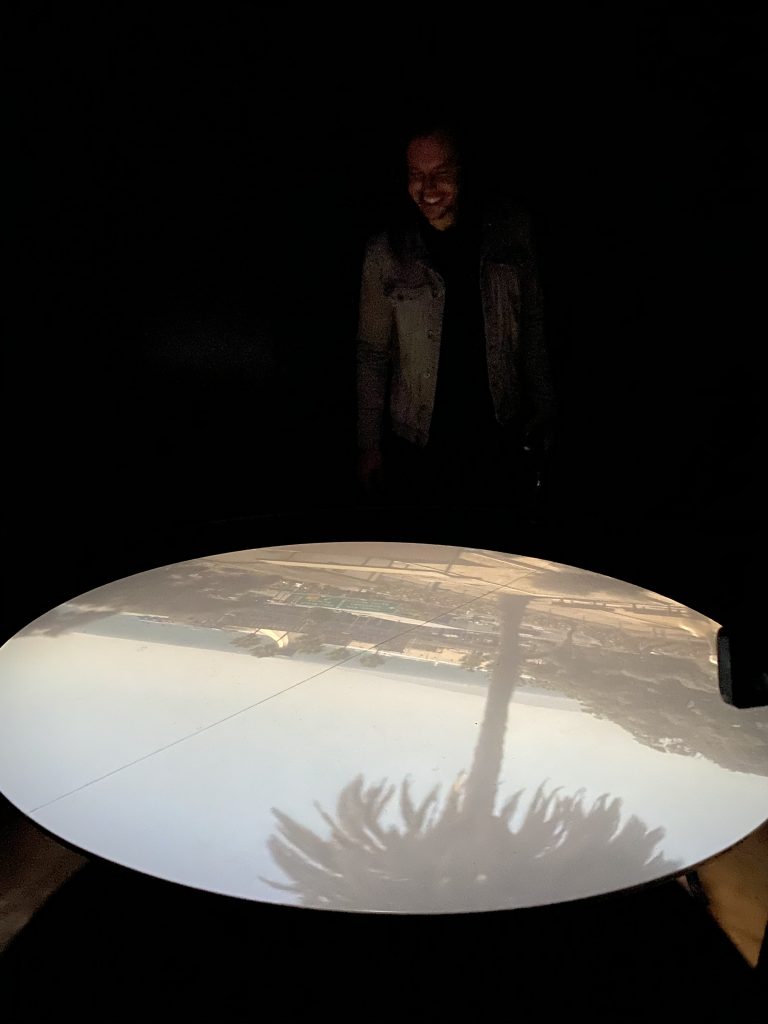
At the center of the room is a large, white table-like surface. On it, you can see a live-action feed of the activity outside: people walking, palm trees swaying, and the ocean glimmering and rippling under the Southern California sun.
There’s a ship wheel to the right of the screen and you can turn it to adjust where the camera points.
You can stare out at the ocean, spy on couples at the Pier, or watch the unique specimens along Ocean Avenue…all from a little dark room in the Senior Art Center.
Even though we live in the digital age, this type of analog experience is so rewarding and fills that void that modern technological advancements can’t seem to fill. I may be biased, though, since my job is to literally handle old objects all day, everyday.
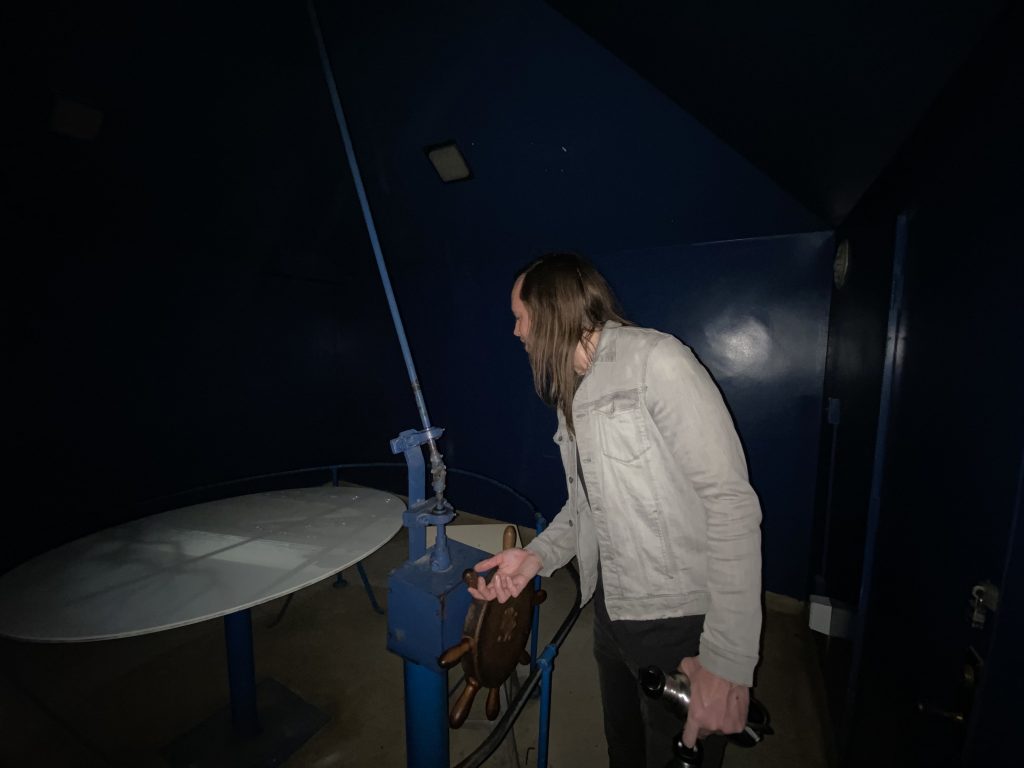
Show Me Your Historical Cameras!

Have you ever been to the Camera Obscura in Santa Monica? Or have you ever used an authentic camera obscura? Let me know in the comments below! 🙂
Also, tag me on Instagram @amara_andrew to show me your cool, historical camera/s! 🙂

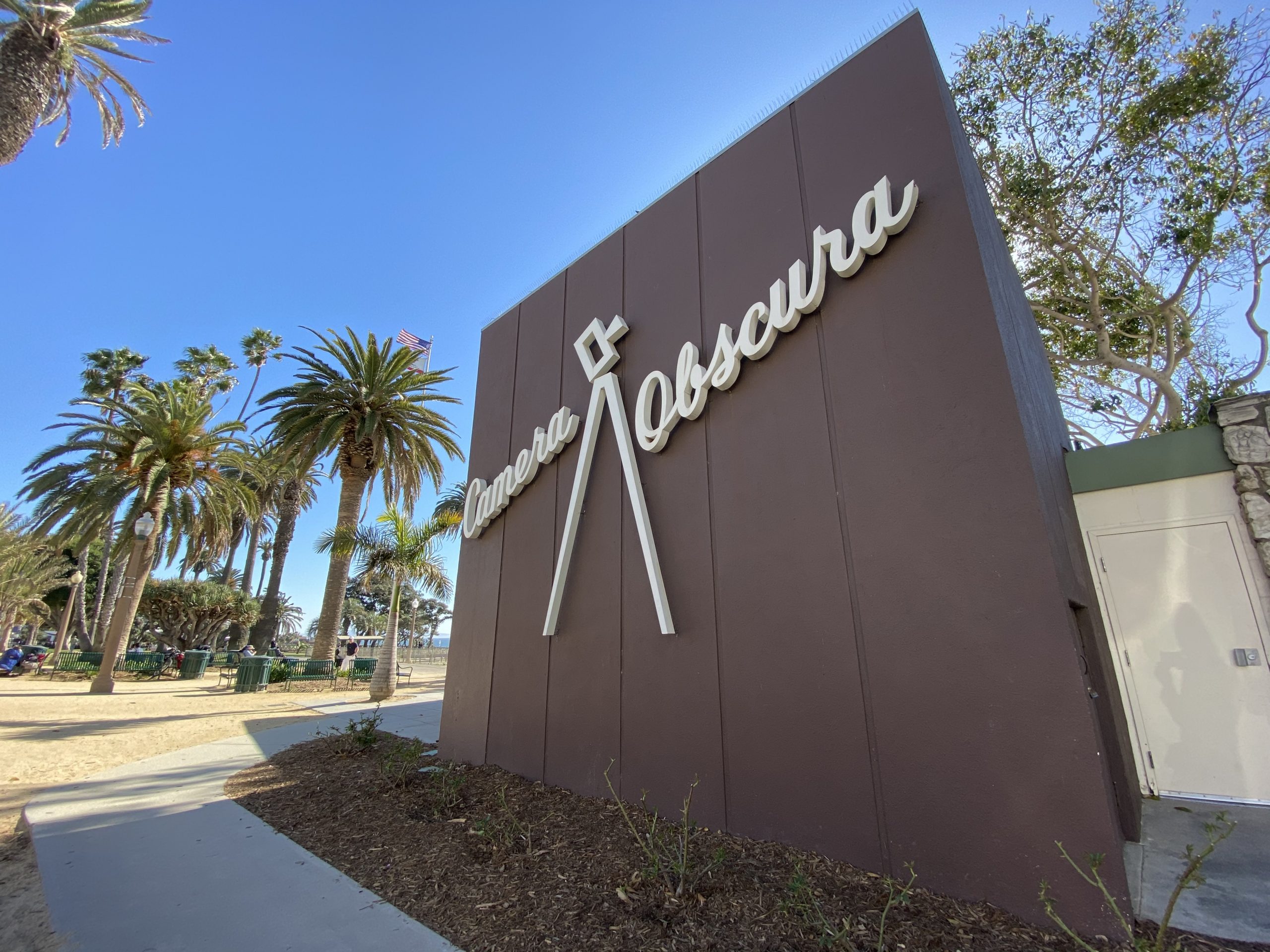
Leave a Reply